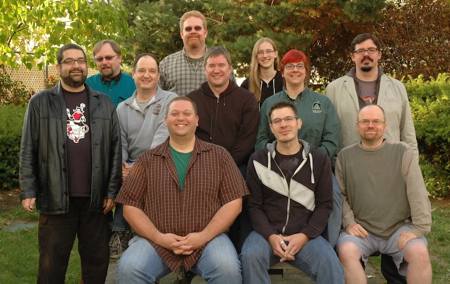Ronin Round Table: Jon Leitheusser
My name’s Jon Leitheusser* and I’m the Developer for Mutants & Masterminds and DC Adventures. I’m here to talk about what a developer does. It’s a little hard to explain because if I’m doing my job correctly, it should be mostly invisible to the outside world. The people who have the best idea of what I do are my writers, because I tell them what to write and help them to fully develop their ideas.
But wait, let’s take a couple of steps back, because the writers don’t actually get involved until a bit later in the process and it’ll be easier to explain things if we start at the beginning.
First, I’m the one who determines how we, as a company, want to approach my game lines. So, I’m the one who pitched the idea that we should make M&M 3rd Edition as easy as possible for people to get started playing right away. That’s why we set this edition in a new city unburdened by the history already fleshed out in previous editions of the game. That’s also why we released the GM screen with a random character generator that made it easier for new players to create characters and start playing without reading a 232-page rulebook. For the GM, we also wanted to make running games easier, so we released the weekly Threat Reports and the
ongoing Heroes Journey adventure series. All of it is an attempt to make it easy to jump into the game.
Second, I’m the one, with the rest of the company’s input, who determines what books we’ll be releasing and in what order. This is also the stage in which we decide which ideas have merit and which don’t. Some projects make it onto the schedule because they need to be released (like the core rulebook). Other ideas make the list because we know the fans want them. Still other ideas are slotted for "further development," which means they need some more think-time before they’re ready to hit the schedule. Sometimes those books make it onto the schedule, sometimes they’re shelved permanently.
Once I have the schedule I create an outline for each book, though any given outline could be written by me or Steve, or whichever writer has a good handle on what that book is about. The outline breaks down each chapter, what needs to be covered in those chapters, any sidebars or specific topics that need to be included, and the number of words for each section. Sounds fun, eh?
When the outline is finalized, usually after I’ve read it over and bounced ideas about how to improve it back and forth with the writer (one could say, further developed the idea), it’s time to hire the writer or writers and break the book into sections for each writer to tackle. This is the time of contracts! Administrative work is fun!
Then, in theory, the writers write and turn their work in on time! More likely the writers eat bon-bons and watch the latest super-hero cartoons and call it research until I email and ask them how the manuscript is looking, then in the last couple of weeks before deadline they write like caffeine-powered madmen and ask for a couple extra days on their deadline, which I kindly grant.
With the completed manuscript in hand, I give it a onceover to make sure it looks correct. If I feel the writer didn’t do exactly what was asked of them, or didn’t cover a section in-depth enough, or if something he or she wrote gives me an idea for something to expand upon, I ask the writer to dive back in and re-write, add, or expand. I play the role of editor and critic. At this stage, and all the others, I try to make the product better. Not to imply that the writers aren’t trying to do that, but they’re often so down in the weeds trying to crank out words that make sense together, that they forget to look up and consider how each piece fits into the larger whole.
When the rewrites are done the book goes off to editing. Editors further improve upon the state of the manuscript. Like the developer, the editor’s job is to make the writer look good. I often say, if there’s anything wrong with a book it’s my fault, and if there’s something great about the book it’s because of the writer. Not because I (or the editor) don’t want to take credit, but because we’re there to catch the writer’s errors and let the writer’s ideas shine through.
We’re in the home stretch now! Somewhere in the last couple of steps, I work with the writer to come up with art descriptions for the interior art (cover art was taken care of in the early stages). Art descriptions are fun but also challenging because you need to come up with images that help illustrate what the nearby text is discussing. Sometimes that’s easy, sometimes not so much. Descriptions for these tend to be a short paragraph with an image or two as reference for the artist. Hal Mangold, who I’m sure you’ll hear from in a future Roundtable, uses these descriptions to commission artwork. Hal, the writer, and I see early sketches and give the artist comments on what (if anything) needs changing before he or she finishes the image.
With the final manuscript and art in hand, it all goes to Hal for layout. When it’s done we do a final proofing run to find anything obvious that needs fixing. When the book is in an acceptable state we release the PDF and collect any corrections we missed from our fans on the Atomic Think Tank provide us (thank you so much!), which Hal makes to the files before the book goes to press.
And then it’s onto the next book!
There it is. My job as Line Developer. It’s not as fun as writing and designing all the time, it’s also not as detail-oriented as being a full-time editor. Hopefully now that you’ve read about what I do, you can see the hand I’ve had in the last few years’ worth of M&M products.
That’s more than enough reading for now… Go play a game!
*It’s pronounced “light-houser.”

 Welcome back to the Ronin Round Table! My name’s Steve
Welcome back to the Ronin Round Table! My name’s Steve